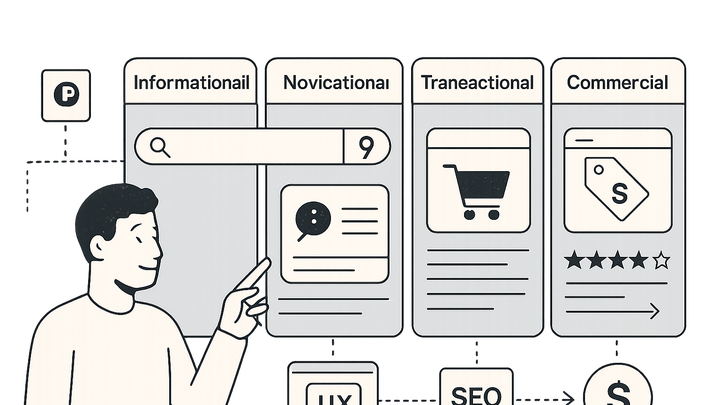Published on 2025-06-29T19:28:09Z
What is Search Intent? Examples for CRO, UX & SEO
Search intent is the primary goal a user has when entering a query into a search engine. Understanding and aligning with search intent is crucial for effective SEO, as it ensures your content matches what users are actually looking for. In the realm of CRO and UX, tailoring page elements to different intent types can dramatically improve user satisfaction, reduce bounce rates, and increase conversions. Search intent generally falls into four categories: informational, navigational, transactional, and commercial investigation. Tools like Prevue.me provide actionable critiques to optimize your content strategy, UX design, and accessibility compliance, helping you capture the right audience and drive maximum lead generation.
Search intent
Search intent is the user’s goal behind a search query, guiding SEO, UX, and CRO strategies to meet user needs and boost conversions.
Importance of Search Intent in CRO, UX, and SEO
Discover why identifying and mapping search intent is a cornerstone of successful website optimization strategies. By understanding what users want, you can craft experiences and content that satisfy their needs and business goals.
-
Enhances user satisfaction
Aligning content with user intent reduces frustration and improves dwell time by delivering exactly what visitors are seeking.
- Reduced frustration:
Users find answers faster and are less likely to abandon your site.
- Higher engagement:
Relevant content encourages users to explore more pages and features.
- Reduced frustration:
-
Drives relevant traffic
Focusing on intent brings in visitors who are more likely to interact with your offerings and progress through the conversion funnel.
-
Boosts conversion rates
When landing pages address specific intents, CTAs resonate better, leading to increased form submissions, sales, or sign-ups.
Types of Search Intent
Search queries can be classified by the user’s underlying objective. Recognizing these types helps tailor content, navigation, and calls-to-action effectively.
-
Informational intent
Users are seeking knowledge, answers to questions, or how-to guides.
- Example queries:
how to improve website loading speed
- Optimization tip:
Publish detailed tutorials, FAQs, and educational blog posts.
- Example queries:
-
Navigational intent
Users want to find a specific website or page.
- Example queries:
facebook login page
- Optimization tip:
Ensure clear branding and site links in search snippets.
- Example queries:
-
Transactional intent
Users are ready to make a purchase or complete a conversion action.
- Example queries:
buy ergonomic office chair online
- Optimization tip:
Highlight product benefits, pricing, and strong CTAs on landing pages.
- Example queries:
-
Commercial investigation
Users compare products or research before a purchase decision.
- Example queries:
best CRM software comparison
- Optimization tip:
Create comparison charts, reviews, and product rundowns.
- Example queries:
Analyzing Search Intent with Prevue.me
prevue.me offers a suite of critiques and insights to align your website strategy with user intent, improving lead generation and overall UX.
-
Actionable critiques
Receive targeted feedback on page structure, content relevance, and call-to-action placement.
-
Lead generation insights
Identify high-intent keywords and optimize forms to capture qualified prospects at each stage.
-
Seo & accessibility checks
Ensure your content is optimized for search engines and accessible to all users, enhancing both discoverability and inclusivity.
Best Practices for Optimizing for Search Intent
Implement these strategies to ensure your site effectively meets user needs and ranks well in search results.
-
Conduct query classification
Use tools or manual audits to group keywords by intent before content mapping.
-
Map content to intent
Align each page’s objective with a specific intent type, optimizing headings and CTAs accordingly.
-
Leverage structured data
Implement schema markup to enhance search listings and signal intent-aligned content to engines.
-
Optimize landing pages
Tailor landing page layout, messaging, and forms to support the identified intent and improve conversions.
-
Monitor and iterate
Regularly review analytics and prevue.me critiques to refine content and UX based on performance data.
